Claude Vignon (Tours 1593 – Parigi 1670)
La buona ventura
Claude Vignon
(Tours, 1593 - Paris, 1670)
(Tours, 1593 - Paris, 1670)
The Fortune Teller
Oil painting on canvas
65 x 84 cm.
In frame 94 x 113 cm.
The work is accompanied by a critical study drawn up by prof. Emilio Negro (Bologna)
The subject immortalized in this intriguing painting, called 'The Fortune Teller', is a scene of everyday life that we would have seen frequently in the crowded streets of central Rome at the time.
The protagonists of the canvas are a young fortune teller and a well-dressed nobleman who lets himself be predicted by reading the hand. The gentleman, who listens curiously to the response and with a hint of malice holds his gold necklace in his hands, is in the meantime robbed by an accomplice of the woman, intent on taking the purse out of his pocket.
Although this type of paintings were intended for the decoration of the residences of the Roman aristocrats, who with a hint of self-irony saw themselves in the figure of the unfortunate grullo, were actually harbingers of moralizing messages. Among the many proposals there was certainly the warning towards the desire to know one's destiny without respecting the priority of the divine will that determines it, relying for this on cunning charlatans.
It must be said that, although more than four centuries have passed and certain dynamics have naturally changed, this subject appears extremely current.
Clearly inspired by the Buona Ventura painted by Caravaggio, the painting is part of that line of scenes taken from the painter's favorite street life and which, given the collector's fortune already at the time, were often reworked by many artists, considered a stimulating theme and full of psychological implications.
In particular, the work in question is attributed to the French painter Claude Vignon (Tours 1593 - Paris 1670), presumably to be placed during his years spent in Rome, before his return to Paris, showing the artist's masterful interpretation of the work conceived by Caravaggio.
After his training in Paris by Jacob Bunel, one of the most famous masters of the reign of Henry IV, he moved to Rome around 1609-1610, being part of that large community of French painters, including Simon Vouet and Valentin de Boulogne, who worked in Rome studying and drawing inspiration from both the subjects and the stylistic system of Merisi.
His style therefore amalgamates a formal and chromatic refinement inherited from the Flemish mannerists to the tenebrism of Caravaggesque origin. The skilful use of the play of light, which we can also find in our canvas, is reminiscent of Merisi's works, however, inevitably letting his French origin shine through, which he will never abandon in his painting.
The attention to detail is very high, as can be clearly seen by observing the folds of the clothes, the pleating of the blouse, the velvet of the young man's jacket and the feather that are masterfully rendered with absolute technical ability. Although it is a painting belonging to Caravaggio's light period, the light begins to create a theatrical and intense atmosphere. On the wall behind the figures, the grazing light projected creates an oblique burst that animates the background and the characters are highlighted through the use of contrasts of brightness. The horizontal format of the painting is ideally divided symmetrically into two vertical halves which interrupt the symmetry of the painting.
In good general condition, considering the age of the painting; There are some small scattered touches and some unveiling of the pictorial surface, with some areas without pigment.
The painting is sold together with a pleasant 19th century frame.
ADDITIONAL INFORMATION:
The work is sold with a certificate of authenticity and a descriptive iconographic card.
We take care and organize the transport of the purchased works, both for Italy and abroad, through professional and insured carriers.
It is also possible to see the painting in the Riva del Garda gallery, we will be happy to welcome you to show you our collection of works.
Contact us, without obligation, for any additional information.
Follow us also on:

